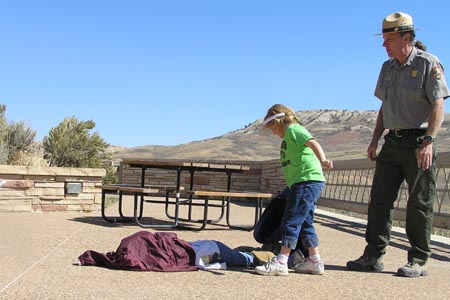Last updated: March 23, 2022
Lesson Plan
Making a Fossil Game

- Grade Level:
- Lower Elementary: Pre-Kindergarten through Second Grade
- Subject:
- Science
- Lesson Duration:
- 30 Minutes
- State Standards:
- Science Standards
Wyoming
Standard 1: Concepts and Processes
Properties of Earth Materials-SC4.1.4 (K-4)
Changes in Earth and Sky-SC4.1.6 (K-4) - Thinking Skills:
- Applying: Apply an abstract idea in a concrete situation to solve a problem or relate it to a prior experience.
Essential Question
How are fossils preserved at Fossil Butte?
Objective
Students will understand how fossils are preserved at Fossil Butte.
Background
Fossil Butte National Monument protects an extraordinarly high amount of fossils that are well-preserved. These fossils are here thanks to Fossil Lake which existed 52 million years ago. The lake's bottom was quite salty and lacked oxygen while the surface was oxygenated freshwater. Because of this, when a fish died and sank to the bottom of the lake, there were no scavengers or decomposing bacteria to disturb the carcass. Mud and algae from the lake's surface sank to the bottom of the lake, slowly covering the corpse. The dead fish fossilized after millions of years before being uplifted and exposed to paleontologists.
This activity applies an abstract concept, fossilization, in a short, hands-on activity.
Preparation
There are two ways to participate in this game. The first one is to come to Fossil Butte National Monument on a scheduled field trip. During the field trip, students engage in several activities including a guided hike, scavenger hunt, and Making a Fossil game.
The second option is to organize this game in the classroom. Make sure students have jackets or coats as these will be used to demonstrate the fossilization process.
Lesson Hook/Preview
Procedure
First, get in a time machine! Inform the class that they're going back 52 million years to when Fossil Lake was still around. Ask a student to be a volunteer. That student pretends to be a fish and swims around in a small area representing Fossil Lake. As the student is swimming, talk about the life of this fish such as its diet and predators. Ask the student to then do their best death impression.
Inform the class that the student-fish sank to the bottom of the lake. Because the lake bottom is pretty salty and lacks oxygen, no scavengers (like bottom-feeding fish) or decomposing bacteria disturb the corpse. As such, this fish is articulated (all the body parts are connected and not jumbled about) and the soft tissue (scales and such) is preserved.
Ask the other students to bring up their coats or jackets and cover the student-fish one at a time (while ensuring that his/her head is not covered). These jackets represent the layers of mud and algae that slowly cover the dead fish.Now it’s time to get back into the time machine! Going forward in time, the soft layers of mud turn to rock and the lake dries up. The whole area uplifts and softer rock is eroded by wind and water leaving Fossil Butte and the surrounding ridges. Students get out of the time machine and into the present. Tell the students they are now paleontologists and their job is to excavate some fossilized fish. Ask the students to retrieve their jackets one at a time until they uncover the student-fish . While this is going on, explain that modern paleontologists excavate fossils with a variety of tools like large machinery, hammers, chisels, and rock saws.
The student-fish is now uncovered and ready to be put on display at Fossil Butte National Monument! Give the student-fish a round of applause.
Vocabulary
Fossil: Evidence of prexisting life preserved in the rocks.
